Civitavecchia, Italy, gets thousands of visitors a day even though is not known as a tourist destination. As a matter of fact, you wouldn’t even find it listed in most tour books were it not for its location. So the question is, What’s the attraction and why do so many people visit?
Here’s a hint: Rome is not on the water.
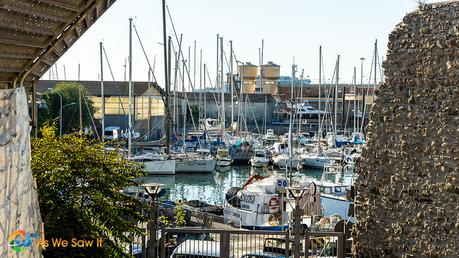
Situated on the Tyrrhenian Sea, Civitavecchia has been a seaport since around 100 AD, when the Roman emperor Trajan built a harbor there. The name Civitavecchia means “ancient town.” I would guess it earned its name because it was built over an Etruscan settlement. (That early settlement wasn’t a port, though.)

Rome’s port
All Rome-bound ferries and cruise lines dock at Civitavecchia. Most people head straight to the train station but actually, there is really no need to hurry off. Nor is there any reason to rush into town only a few hours before a cruise begins. There is plenty to see and do in the port as well.
Civitavecchia (pronounced chee-vee-ta-VEK-ee-uh) is an excellent option for anyone who wants to enjoy a tranquil day meandering instead of dealing with the hustle and bustle of big-city Rome. Super clean and pleasantly relaxing, it has a well kept promenade along the sea and is chock full of shopping opportunities and open air cafes.

Three days in Civitavecchia
In 2013 we found an incredible deal on an 11-day Mediterranean cruise—8 fabulous ports in four countries on the Adriatic Sea. The cruise began in Civitavecchia (Rome) and ended in Piraeus (Athens), and we’d only been to one of the places before. It was too irresistible to pass up.
To begin our cruise, we had two options:
- Arrive in Civitavecchia the morning of the cruise—which meant taking a morning train into town, or
- Arrive in Civitavecchia a few days early—which would allow us to explore the Italian port at our leisure and enjoy some fine Italian cuisine.
The second choice sounded a lot more appealing.

If I were to have one regret about our time in Civitavecchia it would be that we never left the city. The entire area is full of Etruscan sites, and we both love ruins and ancient history. We could have toured Tarquinia and Cerveteri, two UNESCO World Heritage sites, or traveled to nearby Tuscania to explore on our own. (Thanks to a guest poster who lives there, I do have an interesting article about Tuscania, though. You’ll enjoy it.)
Read more: Etruscan Places: Tuscania
Closer to the city we could have visited Terme Taurine (“Trajan’s Baths”), Trajan’s well preserved villa and thermal baths and then indulged ourselves by soaking away our own aches and pains at the nearby Ficoncella hot springs. Sadly, we didn’t do either of those.
Wheeling our carry-ons behind us, we followed the throngs leaving the train station onto a busy street along the seafront. The street saw thousands of people a day, migrating to and from the ferries and cruise ships in the distance.
Our Civitavecchia walking tour
It was an easy walk to our hotel – only 100 yards or so down the road, and easy to find. Our hotel offered free maps of the city which included two walking tour itineraries, historical and religious. Since we enjoy both ancient ruins and visiting churches (so much art!), we decided to combine them and sat down at the breakfast table to plot our route. Before long we had a map full of lines and a day to look forward to.

Our map was more detailed, but you get the idea.
Here are some of the things we saw.
Ghetto
With all its old buildings the former Jewish ghetto is picturesque and full of life, an area where we saw few tourists.
The Piazza Fratti became our favorite spot in town, with authentic and quality food at a reasonable price – and without tourist traps. We ate two dinners and one lunch there. We knew that we would be eating at a place that expected locals, rather than tourists, when we entered and were greeted in Italian. Love that!
Italians eat dinner after 7:30 and take all evening socializing over their meals. We ate earlier so we could be sure we would find an available table.
Tip: If you are unsure which restaurant to choose, opt for the most crowded one. A busy eatery is a good indication that the locals like the food.

We took this photo in mid-afternoon, before aperitivo (happy hour)
Corso Centocelle
Not far from the shuttle terminal is the main pedestrian walkway, Corso Centocelle. It is usually crowded with tourists because of its numerous shops, buskers and al fresco eateries, but two things to watch out for are the Trajan Theater and the Etruscan excavations on view below the sidewalk.


Piazza Regina Margherita
At the far end of the walkway is the square for Il Mercato, Civitavecchia’s traditional market. We were fascinated by the local products that were there and purchased some cheese to snack on.

Then we went in search of the nearby fish market, which our desk clerk had recommended. It was only late morning and they were already closing up.

After a wander through to see what they were hawking we were surprised to find another market on the other side, selling a variety of meats including (ew!) horse.
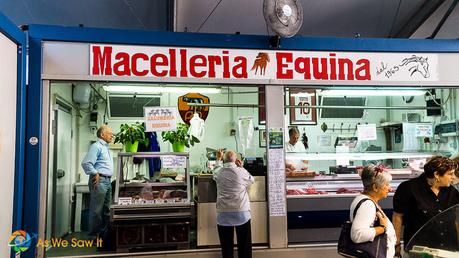
Chiesa della Stella
The church is the starting point of Civitavecchia’s traditional Good Friday procession – one of the annual events that the entire town participates in. Inside are frescoes by a local artist, a valuable wooden crucifix from the 1700s and a statue of Our Lady of Mercy.

Piazza Leandra
Nearby is Civitavecchia’s historic center, centro storico, which is almost completely free of tourists. Piazza Leandra enchanted us with all its cobbles and green shutters and laundry hung out to dry.


We especially liked an old stone tower sandwiched between two old houses. On the other side we found some buildings that had been built into the wall.


Santa Maria dell’Orazione e Morte
Like many others in town this Baroque church has beautiful frescoes on its walls, but it is probably the only one that has a balustrade from the stern of a boat inside. It is also home to the wooden statue of the resurrected Christ that is carried in the Easter Procession.

Our map called this church “a true Roman basilica in miniature” because of its elegant elliptical shape and its dome, which was painted in 1788 by Giuseppe Errante.

Darsena Romana
The Roman dock that was built back in Trajan’s day still exists, though not much else. Civitavecchia was almost completely destroyed in World War II.

The old Roman seawall is still visible.
Our map mentioned two older structures: a fortress called “La Rocca” and “il lazaretto,” a hospital for contagious diseases. It took a while to get there and once we arrived there wasn’t much to see. We were thwarted by fences, maybe due to the severe bomb damage they received during the second war.
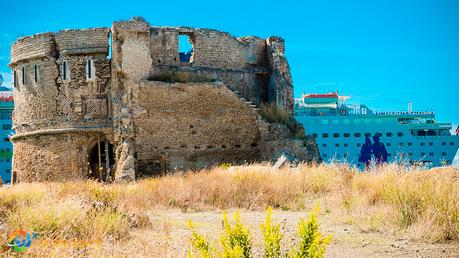
It wasn’t worth trying to see the two buildings since we couldn’t get inside. As you can see, the views are just as good, if not better, from aboard ship.
From there we passed through the harbor and marina, along the “Principe Tommaso” promenade and past a 17th century defense wall that was built by Gian Lorenzo Bernini. Yes, that Bernini, the same person who designed St. Peter’s Basilica. Why would a famous artist work on a mundane city wall? Because Pope Urban VIII told him to. (He wanted to protect the city from naval attacks and I guess he trusted Bernini to do it well.)

A beautiful mask-shaped, travertine fountain, known as the fountain of Vanivitelli, is the only decoration on the wall.

Forte Michelangelo
Forte Michelangelo is impossible to ignore, partly because it’s so imposing but also because the shuttle drop off point for the cruise ships is directly in front of the fort. The fortress has 6-meter-thick walls and is still in perfect condition, though it no longer has the moat that once surrounded it.

Forte Michelangelo got its name because Michelangelo had designed its central tower. Like all other forts it surrounds a central courtyard.
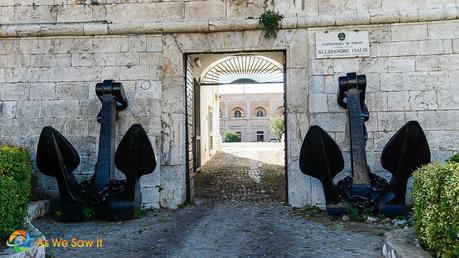
Entrance to Forte Michelangelo
We were told it was a museum and walked through the old entrance expecting to pay an admission fee. No one was around so all we got to see was the courtyard and the bronze pulley that was once used to lower and raise the bridge.

St. Francis Cathedral
Through the gate we walked, back into the city teeming with shops displaying their wares outside their doors. Making a U-turn, we detoured back to the city Cathedral in Piazza Vittorio Emanuelle, which reportedly has a fresco depicting St. Francis receiving the stigmata. Another disappointment: The doors were closed and we couldn’t enter.
Perhaps we’d have more luck at our next destination, nearby Chiesa della SS. Concezione. This 18th century church, they say, has a painting of Our Lady of Mercy that has moved its eyes. But no, that was closed as well.

Well, at least we were able to see the war memorial outside.

Unconditional Surrender
No one in Civitavecchia can miss the colorful, larger-than-life statue of a Navy sailor kissing a nurse on the seaside promenade. It is called “Unconditional Surrender.” This statue is one of many around the world that depict the famous Eisenstadt photo taken at the end of World War II in Times Square.

The warm breeze and calm ocean beckoned us to the water’s edge. We watched some nearby fishermen for a while, then Dan had me sit on the rocks to pose for a photo.

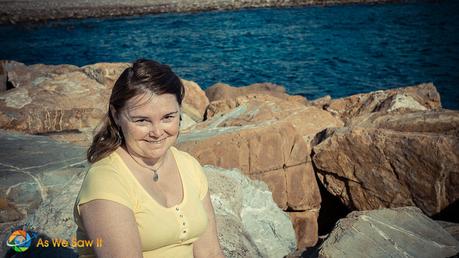
It’s hard to smile when the blinding sun is shining in your eyes.
We walked the length of the promenade, enjoying the peace and quiet. At the other end of the promenade we found a beach, a pier, and a collection of eateries. By this time it was late afternoon—time for aperitivo—and we joined other Italians in a bar for a glass of wine. Verdict: For a day in the sun, the pristine, sandy beach is worthy, but the graffiti-covered pier looks better from a distance.
Where we stayed
Dan booked us into the Hotel de La Ville, a large 19th-century mansion-turned-hotel located right on the waterfront promenade. It looks luxurious from the outside and feels even more so once you pass through its doors. In the foyer are huge urns of flowers, white-and-black marble underfoot, and an elevator and carpeted marble staircase leading up to the guest rooms.

An elegant, four-star hotel at an affordable price, it was so conveniently located that all passengers walking from the train station to the cruise port passed by its doors. The windows in our room opened out to a wonderful sunset view of the Tyrrhenian Sea, but our favorite part of the hotel was the taverna/breakfast room in the vaulted cellar. It was built within the walls of ancient Roman baths. Highly recommend it!
(Visited 2 times, 2 visits today)
